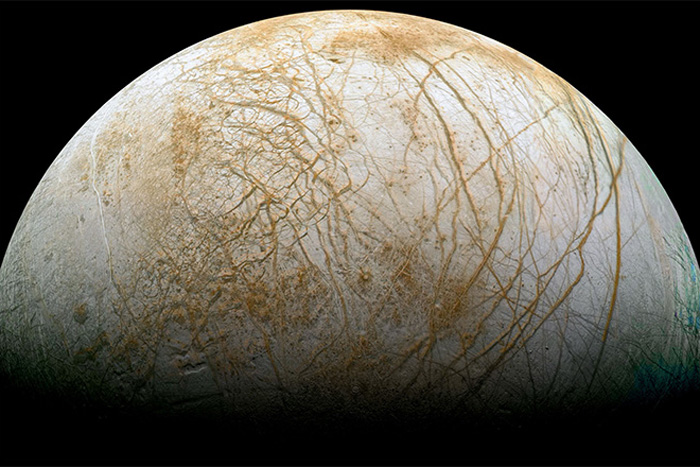Europa's Deforming Ice Is a Surprising Heat Generator

As excitement builds for NASA's Juno mission that will enter Jupiter orbit this summer, and future missions that will investigate ice moon Europa's life-supporting potential, new research into the strange qualities of the moon's cracked crust could reveal some fascinating science about Europa's sub-surface ocean.
Researchers of Brown University in Providence, R.I., have melded observations of Europa with computer models and laboratory experiments to reveal the tidal compression caused by Jupiter's hefty gravitational field could cause the moon’s fragmented ice to generate more heat than thought, creating exciting new implications for the search for Europan life.
PHOTOS: Where in the Solar System is it Possible for Alien Life?
Before NASA's Voyager and Pioneer flyby missions in the 1970s and then the Galileo mission in the 1990s, we had little clue about the dynamic nature of the Jovian satellites. "(Scientists) had expected to see cold, dead places, but right away they were blown away by their striking surfaces," said Christine McCarthy, of Columbia University who carried out research into Europa's ices while a graduate student at Brown University. "There was clearly some sort of tectonic activity — things moving around and cracking. There were also places on Europa that look like melt-through or mushy ice."
It is now known that Europa possesses an extensive sub-surface ocean of water, protected by a fragmented, icy crust that appears to move much like the continental plates on Earth. Tidal pressures created during Europa's orbit around Jupiter create an internal dynamo, which gently heats the moon from the core, maintaining the ocean in a liquid state. In addition, the motion of the icy plates are thought to generate their own heat through frictional processes at the boundaries. Much like the heat produced when repeatedly bending a wire coat hanger, heat is dissipated through the repeated tidal flexing of Europa's crust at these boundaries.
NEWS: These Bacteria Could Live in Europa's Ocean
But the small-scale processes behind this tidal dissipation are poorly understood and may have been woefully underestimated.
Breaking space news, the latest updates on rocket launches, skywatching events and more!
"People have been using simple mechanical models to describe the ice," said McCarthy, "they weren't getting the kinds of heat fluxes that would create these tectonics. So we ran some experiments to try to understand this process better."
To simulate what might be going on in Europa's crust, McCarthy headed a project to simulate the tidal pressures that would be felt by Europa's ice in the lab. Loading ice samples into a compression apparatus at Brown University, the amount of deformation and heating could be measured.
Until now, it has been assumed that the majority of heating comes from friction between individual ice grains, so that would suggest the frictional heating is directly related to the size of the grains. But on varying the ice grain size in her samples, McCarthy noticed no difference in heat flux. Instead, she realized that the bulk of the heating comes from microscopic defects in the ice's crystalline structure as the ice was deformed. The greater the deformation, the more heat is generated.
PHOTOS: Fire and Ice: Tides Drive Jupiter's Ocean Moons
"Christine discovered that, relative to the models the community has been using, ice appears to be an order of magnitude more dissipative than people had thought," said collaborator Reid Cooper of Brown University. "The beauty of this is that once we get the physics right, it becomes wonderfully extrapolative.
"Those physics are first order in understanding the thickness of Europa's shell. In turn, the thickness of the shell relative to the bulk chemistry of the moon is important in understanding the chemistry of that ocean. And if you're looking for life, then the chemistry of the ocean is a big deal."
In short, the realization that the microscopic structure of the ice is generating the heat and that heat generated is way more than can be produced by frictional heating alone, scientists can learn a lot more about the physics of Europa's icy crust and therefore open a new window into the chemistry of the liquid water ocean below.
As NASA plans what instrumentation its future "Europa Clipper" mission should carry to study one of the most fascinating worlds in the solar system, it's fundamental research such as this that could be used to better understand the habitable potential of Europa's mysterious ocean.
This research is published in the June 1 edition of the journal Earth and Planetary Science Letters.
Source: Brown University
Originally published on Discovery News.
Ian O'Neill is a media relations specialist at NASA's Jet Propulsion Laboratory (JPL) in Southern California. Prior to joining JPL, he served as editor for the Astronomical Society of the Pacific‘s Mercury magazine and Mercury Online and contributed articles to a number of other publications, including Space.com, Space.com, Live Science, HISTORY.com, Scientific American. Ian holds a Ph.D in solar physics and a master's degree in planetary and space physics.
